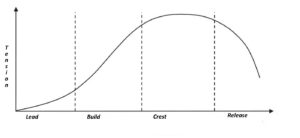Can we agree that it is a good thing to know how to let go of anger without scaring or alienating anyone? Focus on the “let go of anger” bit: if you could let go of anger reliably, every time you need to, would you?
Take the red pill
“You take the blue pill, the story ends, you wake up in your bed and believe whatever you want to believe. You take the red pill, you stay in Wonderland, and I show you how deep the rabbit hole goes.”
Next time anger finds you, will you stuff it away and pretend it has no hold on you? That’s the blue pill. Stop reading now and you can keep your world intact and undisturbed.
The red pill is the way to let go of anger. The truth. Anger just is. We get angry for good reasons. We can fully experience anger without the need to fully express it. That’s the red pill.
The rabbit hole
Like Neo’s first encounter with the Matrix, we spend much of our time denying ourselves feelings that aren’t “appropriate,” don’t we? “Don’t be afraid!” “Don’t let anybody see you cry!” “Getting angry isn’t how we do things in this house.” Sound familiar?
That way of thinking has become so ingrained in us that we believe it is normal: normal people don’t get angry; normal people don’t get afraid; normal people don’t cry. That’s blue-pill thinking. Normal people do experience all those emotions; suppressing them is one way to crazy, and it gives away power to people who’ve taken the red pill.
A “normal” emotion is a fully-experienced emotion. And like the Matrix, the emotional red pill rabbit hole leads, not to crazy, but to power.
Fear and understanding
We can’t fear what we understand. Emotions like fear and anger can be scary until we understand them. To over-simplify, emotions are the guardrails that keep us safe on the road of life. Ignoring them (or stuffing them away) weakens our ability to deal with life.
In their essence, emotions are chemical signals that prepare our human systems for a response. In any given situation, there are always a few responses that are better than others, and it’s the job of our emotions to point us towards those better responses.
If we cut ourselves off from experiencing fear and anger, for example, by practicing suppression of them, we’ve compromised our ability to respond and limited our options by approximately 50%, and we may never consider the best response in a situation that’s tied to anger or fear.
Instead, if we practice a healthy acceptance and experience of anger and fear, we increase our response-ability. How? By allowing the emotions (anger and fear) we also allow the potential for responses based on them, and those responses could save our lives.
Here’s an obvious example.
Unafraid of the tiger
For a moment, imagine a prehistoric family. The family’s biggest predator was the prehistoric tiger. It’s good to recognize the danger such a tiger poses to the family, and prehistoric people were well-attuned to signals that tigers were near. Tiger sounds probably got the family’s attention, and their healthy fear of tigers keep everyone safe.
It would be stupid for a prehistoric family member to walk up to a dangerous hungry tiger and say “I’m not afraid of you!” Denying fear, in this case, would have been deadly stupid.
What about anger?
A tiger that eats a prehistoric family member doubtless encourages that family to anger. It may have taken many generations, but eventually, the family’s anger would empower them to make defensive weapons, find places of refuge from tigers, teach their young to be aware of their emotional triggers that mean “tiger.”
Anger and fear actually trigger powerful physical responses in us. Racing hearts pump the blood we need to run away or fight, and adrenalin is part of the fear/anger chemistry that makes us do that. Our vision and brainpower seem to clarify at these moments as well. These emotions are high-impact and quick-response; it takes a while for their effects to wear off.
In the office?
Just because we’re primed by fear or anger it’s not necessary to carry out some physical act to let those feelings flow. There are practices we can use that allow experience of the “dark” emotions of fear and anger without the expression of them, and it’s the expression of fear and anger that scare and alienate co-workers.
So, experience these helpful emotions without expressing them.
It’s guaranteed that anger and fear will find us wherever we are, including with our families and at work. Some workplaces allow – even encourage – the non-violent expression of anger and fear; some workplaces, including a few that we idolize like football, hockey, and boxing, are based on the violent expression of fear and anger. In both cases, there can be strict rules around how this works, and well-rehearsed strategies for how to employ both fear and anger to the team’s advantage.
Unless you are one of the few who plays professional contact sport as a livelihood, consider your workplace for a moment. Think about what and who makes you angry. Can you predict the situations and circumstances where your anger will be triggered? Of course, you can!
Anger in the office
It’s not pleasant to have the boss yell at us, but it happens. By unwritten agreement, the boss gets a larger bandwidth in which to express emotions. Most of the time, there’s a valid reason for the anger that prompts the boss to yell at us, whether individually or as a team.
Most of the time, the boss’ expression of anger has an effect of some kind.
If the anger was appropriate, it can also help prompt us to respond more effectively to the underlying trigger…the thing that angered the boss in the first place.
Appropriate or not, unless we’re the boss, our ability to express anger is much more limited.
Whatever the bandwidth our position allows, we can still experience the anger.
How to experience anger without expressing it
If there was a way to fully experience anger at the office would you do it? Would you do it without having to break things and hurt people, even verbally? Get ready: here’s how to do that.
When the anger trigger happens:
- Get out your favorite music app and some headphones
- Choose the song that makes you angrier than any other song you know
- Find a quiet, safe place, where you won’t be disturbed for a few minutes
- Put on your headphones, put that song on repeat, and listen until your anger dissipates
Easy?
Notice that the music you use – just one song! – isn’t about diverting your anger or stuffing your anger or getting you to relax. Instead, it’s about allowing and experiencing the anger.
Got it?
A few minutes in timeout
This musical timeout will revive your non-angry attitude because once anger flows through us, its chemical effects dissipate. We want that healthy flow much more than we can endure the suppression of anger or fear.
This practice is similar to how combat soldiers drill to lessen fear’s impact on their work. Carrying out a military maneuver – or executing a play in pro sports flawlessly – requires precision, and practice builds the muscle memory and mindset to execute the steps in spite of emotional experience.
It’s also a practice that’s similar to the way monks enter a meditative state: allow and notice the thought/feeling then let it go.
If your musical timeout leaves you with unfinished experience of anger (or fear or sadness for that matter), go back to it when you can.
If you simply feel flat after a few minutes under the headphones, you’re probably done. That flat feeling – the kind of active neutral tennis players get when preparing to receive a serve – is a great place to take charge of what you feel and offer yourself an emotional direction. Play a song that triggers happy, or concentration, or physical energy – whatever you feel you need to jump back into the workplace for the next thing on your agenda.
Teach your colleagues
This practice – call it “musical timeout” – is effective, safe, and free of unwanted side-effects. There are call centers that have listening booths for stressed-out and angry workers for this very reason. When you show this practice to your co-workers or colleagues, point out the necessity and wisdom of staying with the anger or fear that was triggered instead of trying to mask it or stuff it. Your self-evident good results will convince you that this practice works, and if you have time to read widely there’s plenty of research and thousands of years of evidence to support you.
You’re not alone
All of us could use a little help once in a while. Our team is here for that. Bounce ideas around with us; ask questions; tweak good practices until they’re great. Reach out here. There’s more great how-to below or at this link: 7 Tips to Overcome Your Fears.
Ready for a deeper dive? The Musimorphic Quest, a fully-mentored online active-learning experience, will immerse you in practical ways to meet life’s challenges with skills you may not realize you already have. It’s not for everybody, but you are that unique individual who really resonates with with the power of music and wants to learn to wield it with skill, give it a try. The landing page is here.



